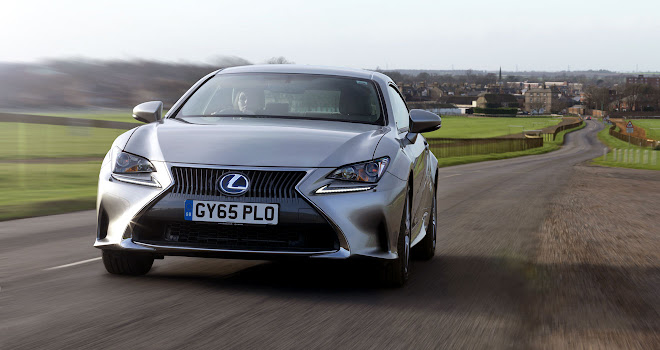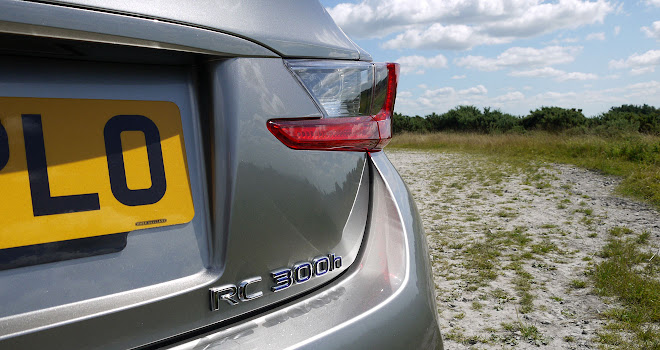
Rating: stars
Good: imposing looks, comfortable cabin (for two), excellent economy
Bad: fiddly controls, small boot, adaptive cruise should be standard
Price: from £34,995
Television advertising for the Lexus RC focuses on the car’s arresting looks, rather than its fuel-saving hybrid heart. If the lingering glances directed at the car during the week I spent with it are any guide, those ads aren’t an idle boast. People do actually stop and stare. I assume in admiration rather than horror.
Partly that will be simple rarity – the first RC 300h only arrived in the UK in January and it will never be as common a sight on British roads as a BMW 4-Series. While driving it, I saw precisely none coming the other way.
I like the design. It’s bold, eye-catching and muscular but not as brutally angular as some other current Lexus models. I’m not wild about the black plastic strakes in the rear bumper, and I’d also question the crease that droops along the front wing from the door mirror to the headlamp. But everything else looks good to me. The unusual triangular chop into the flared sill, just ahead of the rear wheels, works particularly well. It catches the eye and underscores that this is a rear-wheel drive car. It draws attention to the hybrid badge stuck there too.

As a booted 2-door, the RC 300h is not a very practical proposition, especially compared to five-door coupés like BMW’s 4-Series Gran Coupé or Audi’s A5 Sportback. Buyers who want more doors will need to look elsewhere, perhaps at the Lexus IS 300h saloon that is closely related to the RC and almost as striking to look at.
Lexus has created a lot of visual differences between the RC and IS, to the extent that you might not mentally connect the coupé and saloon even if you saw them side-by-side. There are marked differences in dimensions too – the coupe is 3cm longer, 3.5cm lower, 3cm wider and sits on a 7cm shorter wheelbase. The tucked-in rear axle gives the RC 300h quite a substantial rear overhang, which Lexus has tried to visually shorten by chopping lumps out of the rear corners. Disappointingly the length doesn’t translate into a large boot, however, which at 340 litres is below average for coupés in the RC’s ballpark.
The hybrid system’s nickel-metal-hydride battery is a culprit, living under the boot floor and gobbling up 45-litres of luggage space.

Rear-seat accommodation also feels quite tight, although getting in and out is OK. You have to drum your fingers while the powered seats chug aside, but they leave a big gap.
Inside, the family ties to the IS 300h are much clearer, given that a lot of the dashboard is carried over directly from the saloon. Mostly this is a good thing – you sit quite low and feel cocooned by high-quality materials in every direction. Leather upholstery is standard and there are bits of cow at your knees and elbows. An analogue clock is an eye-catching feature, sitting prominently in the middle of the dashboard.

The rest of the centre console design is not quite as attractive. The cluster of identical rectangles for controlling ventilation is not the most intuitive layout, and I’d like to have some stern words with whoever signed off the touch-sensitive temperature sliders. I’m sure the idea seemed great on paper but in reality they are an unnecessary fiddle.
Equally disappointing is the stalk-operated cruise control, which isn’t aware of the traffic ahead and so is rarely of much help on UK roads. Surprisingly, adaptive cruise control is an option only on the top trim level, which seems like a big mistake given that the RC is otherwise a very well-equipped, high-tech car.
The multimedia trackpad-style controller is far from wonderful as well. Selections on the central seven-inch screen hop helpfully from option to option as you move your finger, but I found it very easy to overshoot. No doubt I’d grow accustomed in time, and the system probably feels a lot nicer to use in left-hand-drive cars where the touchpad would sit on my more dextrous side. As it is, I found myself reaching across to use my right hand when programming the satnav.

On the subject of the navigation system, I wonder which bright spark decided to put the postcode entry option on page 2 of the programming menu? That’s about as suited to the UK as the RC’s foot-operated parking brake, which I kept forgetting to release.
Those criticisms aside, I found the RC 300h quite a satisfying car to drive. It does a particularly fine job of delivering outstanding fuel economy in a package that doesn’t look like it ought to. Nobody will suspect you of hugging any trees if you drive an RC.
I was very pleasantly surprised by the economy I saw on a day trip from East London to the south coast and back again. Via urban streets, motorways, A-roads and B-roads, the RC hybrid delivered 55.6mpg. That’s a remarkable result considering the official combined-cycle fuel consumption for the trim level I tested, riding on entry-level 18-inch wheels, is barely any better. The car is rated at 57.6mpg, with CO2 emissions pegged at 113g/km.

To be fair I did conduct about half of that journey in Eco mode, most of the rest in Normal mode, and only enough time in Sport mode to assess how it felt. But I kept up with other traffic and generally didn’t do much to eke out my mileage. However, I’m sure it’s possible to achieve much more thirsty figures by using more of the RC 300h’s performance potential.
If you do step down firmly, the RC will indeed get up and go. Combined maximum power is a healthy 220bhp and acceleration from rest to 62mph takes 8.6 seconds.
I found the RC quite entertaining to drive along twisting back roads, helped by ample grip, figure-hugging seats and very little body roll. On poor surfaces you might wish it would roll a bit more, however. Driving over randomly scattered bumps on urban streets the same roll stiffness means the car can end up swaying quite abruptly from side to side. I’ve driven cars that fared worse, but it’s a notable downside if ride comfort is a priority.

Over the majority of surfaces the RC 300h copes well enough, with good sound insulation providing a peaceful interior.
Driving in Eco mode does blunt responses, but not to the extent that you’d never use it. Press the throttle down past the kink in its travel (presumably designed to discourage such shenanigans) and the Lexus will hurl itself forward with conviction even in Eco mode. There’s no need to switch into Sport mode to be sure of making a clean overtake, for example.
With the car set to either Eco or Normal mode – accessed via a large press-and-twist controller on the centre console – the instrument panel will display a demand metre designed to assist economical driving, marked out with Charge, Eco and Power segments.
Switch into Sport mode and the dial will transform into a rev counter by the clever trick of illuminating different sections of backlighting. The Sport setting also perks up engine output and throttle response while reduce steering assistance, to try to provide a more involving drive.

Keen drivers can also knock the automatic gearstick into its manual setting, and use paddles to shift up and down. Used in this way you might almost persuade yourself that the RC 300h is not a hybrid – although I’m not sure why you’d want to do that.
In common with other Lexus and Toyota hybrids, there is neither a conventional automatic nor a manual gearbox but a computer controlled collection of nested gears and clutches that lets the engine rev as required without much reference to road speed. Some people find the resulting disconnection between sound and motion unwelcome, though if you spend a while in a hybrid you soon get used to it.
You can set the colour display in the instrument binnacle to show power flows between the RC’s engine, hybrid battery and electric motor. Sometimes the engine will rev more than expected to top up the battery while also propelling the car, while at other times the engine will switch off completely and you’ll glide along on electric power alone, even at speed. A green “EV” light blinks on among the instruments to tell you when the engine is off.

If you prefer noise you can have that too. A feature called Active Sound Control is available in the mid-range F-Sport version of the RC 300h, which fakes the sound of a throaty engine through the speakers. Happily you can also switch that off. Personally I found the natural engine note reasonably melodious, when you can hear it at all.
The engine is a 2,494cc four-cylinder petrol unit providing up to 178bhp. If that sounds a little weedy for a 2.5-litre, that’s because it is. The engine is designed to use the Atkinson cycle – a way of timing the cylinder inlet valves to favour economy rather than power output.
Alongside the engine is a 141bhp (105kW) electric motor. Both the engine and motor drive the rear wheels, either independently or in tandem.

Prices for the RC 300h start at £34,995 for the Luxury trim level I tried. The top Premium grade costs from £40,495. Prices are roughly on a par with major rivals.
As a petrol hybrid the RC 300h comes with a BIK tax rating of either 19 or 20 percent, depending on the size of its wheels, helping to keep costs under control for company car buyers. The Lexus trims at least 3 percentage points off the tax rate compared to diesel-powered alternatives and will pollute a lot less in terms of NOx and particulate emissions.
The RC is currently a rare sight in the UK and likely to remain so. It may not appeal to the majority but those who do plump for this car will have chosen a great looking coupé that offers a tempting mix of performance and economy.




